The Sámi are Europe’s only recognized Indigenous group, having hunted, fished and herded reindeer across Arctic Europe for millennia before the arrival of Christianity.Today, the Sámi are fighting across their territories to resist mining, logging and energy projects that disrupt traditional activities.Sámi thinkers and religious leaders are pushing Scandinavia’s national churches to become allies in their fight for self-determination.These churches are increasingly interested in better understanding Indigenous Christian theology like that of the Sámi, which may present an alternative to a traditionally anthropocentric worldview. Some churches and followers, however, are not convinced.
In Arctic Norway, among the Indigenous Sámi people, there is a custom: When cutting down a tree, tap its trunk three times.
On the one hand, it’s simply practical advice: Only old, dead trees will ring hollow. Test the trunk, and you’ll know which trees are young and healthy, and leave them more time to grow.
But when Tore Johnsen, a Lutheran priest researching the spiritual customs of the Sámi, asked for an explanation, he heard the practice held another meaning: It was, also, a threefold blessing — a knock for the Father, the Son and the Holy Spirit.
The Sámi are Europe’s only recognized Indigenous group, occupying a broad homeland that spans Arctic Europe from Norway to Russia. For millennia before the arrival of Christian missionaries, Johnsen found, the rites and rituals of Sámi communities helped sustain a distinctive worldview that emphasized respectful equilibrium with the natural world.
“Sámi traditions and our practices all have to do with collaboration — with the place, with animals, with everything that grows,” said Lovisa Mienna Sjöberg, a Sámi theologian at the Sámi University of Applied Sciences in Norway. “You should not take more than is your part to take.”
But more than 600 years after their first encounters with missionaries, Sámi communities are also some of northern Europe’s most devoutly Christian. Mixing Indigenous cosmology and ethics with Christian stories, imagery and theology, the Sámi have, over centuries, evolved a multilayered faith of their own, often in the face of bitter oppression and persecution by puritan churches and state authorities.
“Through the ages, it became something that you think you need to hide, a separate hidden culture — outside the church, but from a Sámi perspective, not opposed to it,” said Jorunn Jernsletten, a senior curator at the Varanger Sámi Museum.
Now, those same churches are hoping to find inspiration in Sámi theology for addressing the climate crisis, throwing off old attitudes about human dominion over nature, and even joining the Sámi in protesting the destruction of their sacred landscapes.
“When it comes to the defense of human rights, you need a good alliance,” said Torbjørn Brox Webber, a Sámi theologian based in Kirkenes, Norway. “[But] the church also has a lot to make up for.”
Reception of the South Sami Hymn Book. Midsummer Day, June 24, 2023, Ankarede. Image by Carl-Johan Utsi/Ikon.
Nature also has an ‘innate holiness’
Despite being one of the most studied ethnic groups in the world, Sámi expressions of Christianity were frequently ignored by the state churches of Norway and Sweden — or, worse, actively suppressed. Many pre-Christian forms of worship, like joiking (sacred singing), leaving offerings at seidas (holy places) or using the noaidi (shaman) drum, were tarred as “demon worship,” Jernsletten said, and persecuted by the church. In 1693, one Swedish Sámi shaman was even tried and executed for the charge.
It’s only in the past few decades that a new generation of Sámi theologians — and majority scholars interested in reconciliation between the church and Sámi Christians — have actively studied the shape of Sámi worship.
Johnsen, who himself has Sámi ancestry, has quickly become one of the leading figures of Sámi theology. “I thought Sami traditions could be a resource in relation to Western Christianity, which I had found to be poor in expressing man’s relationship with nature,” he wrote in an earlier Norwegian study.
Johnsen found that, like the tapping of the trunk, many traditional Sámi expressions of faith involved a “double layer” of meaning: “On the one hand, rites are directed to God the Father, the Triune God, [and] Jesus,” he wrote. “On the other, they are directed toward nature or the Earth, and what lives in it.”
Sámi herders might ask permission of a valley to camp there or make a blessing to prevent the arrival of toxic rains. Speaking ill of the land is not tolerated: “Nature also has power and something to say. You must not scold nature, or call something a ‘dirty lake,’ or something like that,” one interviewee told Johnsen. “Then, things will not go well for you.”
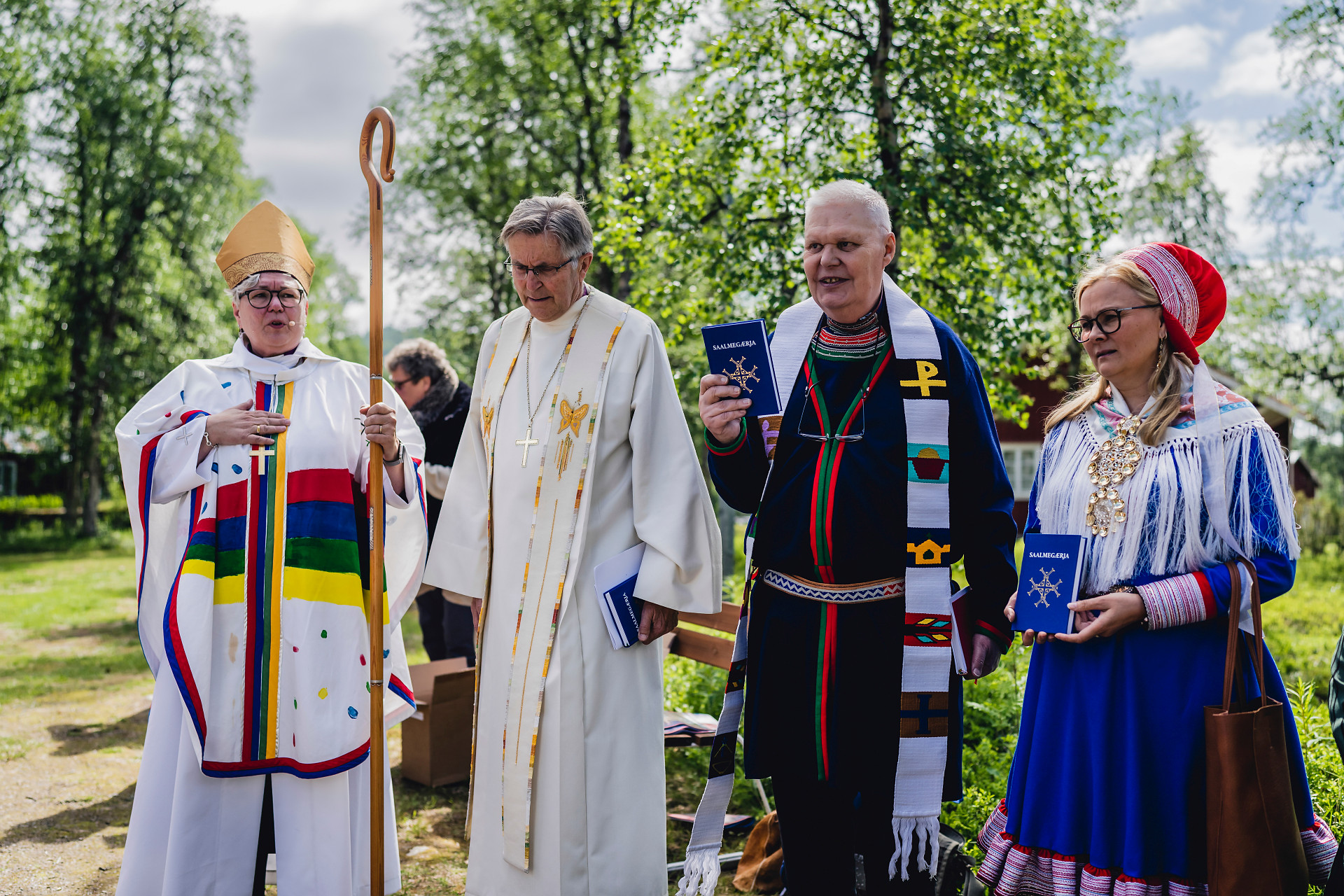 Reception of the South Sami Hymn Book. Erik-Oscar Oscarsson, chairman of the Sami Council in the Church of Sweden, holds the new South Sami hymn book. The new hymn book contains 75 hymns, translated into South Sami from the Swedish and Norwegian hymn books, or with original texts in South Sami. Image by Carl-Johan Utsi/Ikon.
Reception of the South Sami Hymn Book. Erik-Oscar Oscarsson, chairman of the Sami Council in the Church of Sweden, holds the new South Sami hymn book. The new hymn book contains 75 hymns, translated into South Sami from the Swedish and Norwegian hymn books, or with original texts in South Sami. Image by Carl-Johan Utsi/Ikon.
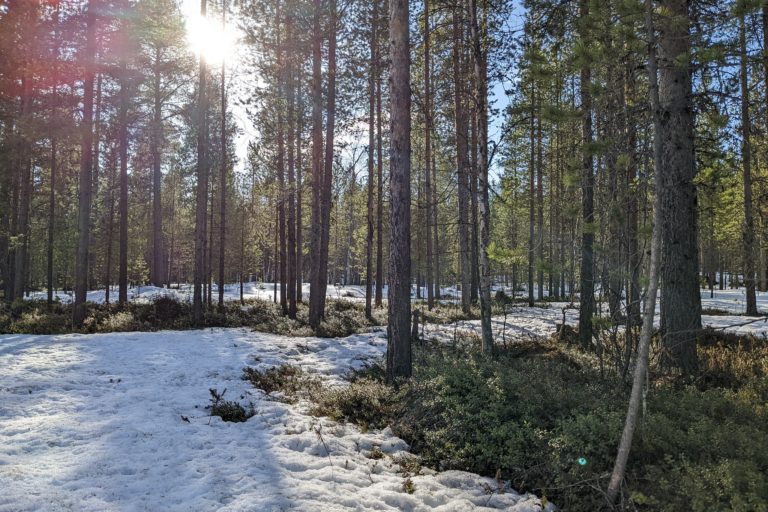 Inari in Lapland, Finland. Image by Karl Chan via Flickr (CC BY-NC-ND 2.0).
Inari in Lapland, Finland. Image by Karl Chan via Flickr (CC BY-NC-ND 2.0).
Johnsen concluded that this understanding of nature, as a sacred place possessing its own power, voice and personality, has given rise to a unique ecological worldview distinct from traditional Christian notions of man’s dominion over creation — “a sacramental view of nature and its benefits,” as he puts it, which sees interacting with the world and its creatures as possessing a kind of innate holiness.
“God, as the creator and sustainer of life, constantly gives us life through the blessings of nature, undeservedly,” he said. “The reindeer meat, the fish and the mullet berries are in a certain sense a sacrament … where God’s invisible grace is given to us through a visible sign.”
This belief also endows humanity with a special duty of care — an obligation to respect and preserve these blessings. “We are the only creatures that can destroy [nature] for everything else,” Sjöberg explained. “So, we have to be even more humble. We have to ask permission when we cut wood. We have to say grace and bless it … because otherwise we can so easily destroy it for future generations.”
These lessons run throughout Sámi folk stories and family lore, which emphasize the total interdependence of human beings, animals and the landscape. “Every element in existence is constituted through its relationships,” the South Sámi theologian Bierna Leine Bientie wrote. “Therefore, the relationships are more important than the elements in and of themselves.”
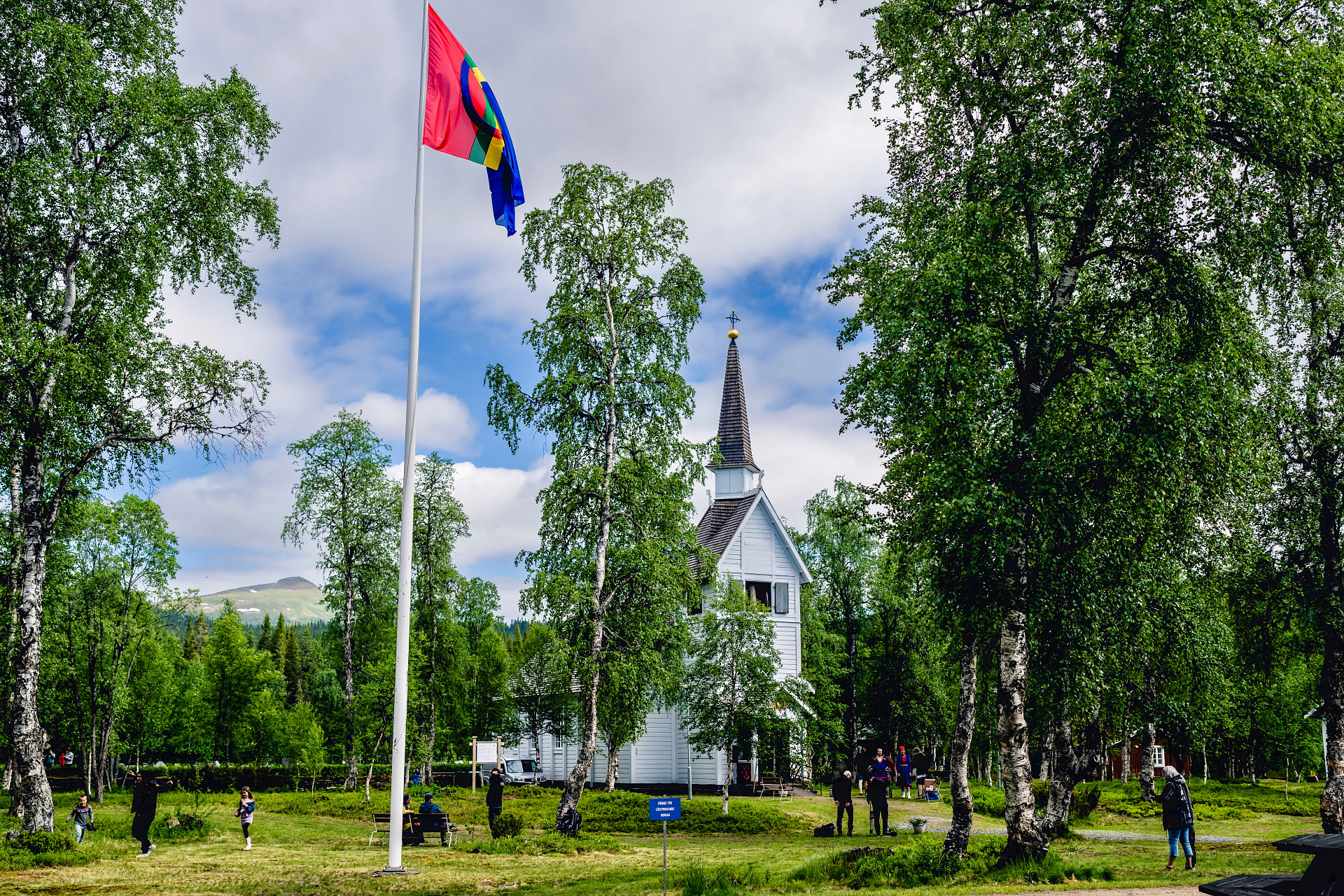 Reception of the South Sami Hymn Book. Midsummer Day. Image by Carl-Johan Utsi/Ikon.
Reception of the South Sami Hymn Book. Midsummer Day. Image by Carl-Johan Utsi/Ikon.
How, how much and what to include?
In recent years, the former state churches in Sámi territory have all sought to make amends for trying to erase and suppress Sámi identity, traditions and spirituality. Truth and reconciliation processes are underway or completed in all three countries; in Sweden, the national Lutheran church made a historic apology in 2021.
Occurring amid a growing climate crisis, those processes have also involved addressing the way these churches have historically ignored Sámi teachings and participated in the degradation of the environment in pursuit of energy and profit.
As an Arctic people, the Sámi have been particularly impacted by climate change, which has disrupted many traditional activities. Thawing and freezing driven by warmer-than-average winter temperatures can lock vital pastures beneath layers of ice, forcing herders to abandon historic and even sacred pasturing sites. Invasive species, like pink salmon, are transforming the ecosystems in rivers and lakes maintained by Sámi fishers for centuries. And the vast and open lands of the north are often targeted for green energy projects, like windmills and dams, or exploited for valuable minerals that can be used to make batteries.
Former state churches like Sweden’s, meanwhile, are often the owners of vast tracts of lands, including valleys, mountains and forests sacred to the Sámi. This has, at times, put them at odds with Sámi Christian activists calling for the return of lands or co-management with Sámi communities.
But a message of cooperation seems to have been accepted by some in the church hierarchy. In October 2023, amid historic protests against an illegal wind farm development in Fosen, Norway, Oslo’s Trinity Church opened its doors to protesters, becoming a hub for organizing.
“They actually went to the action for the first 24 hours,” Sjöberg said. “Then, they asked the activists, ‘What can we do for you?’ Like Jesus did in the Bible.”
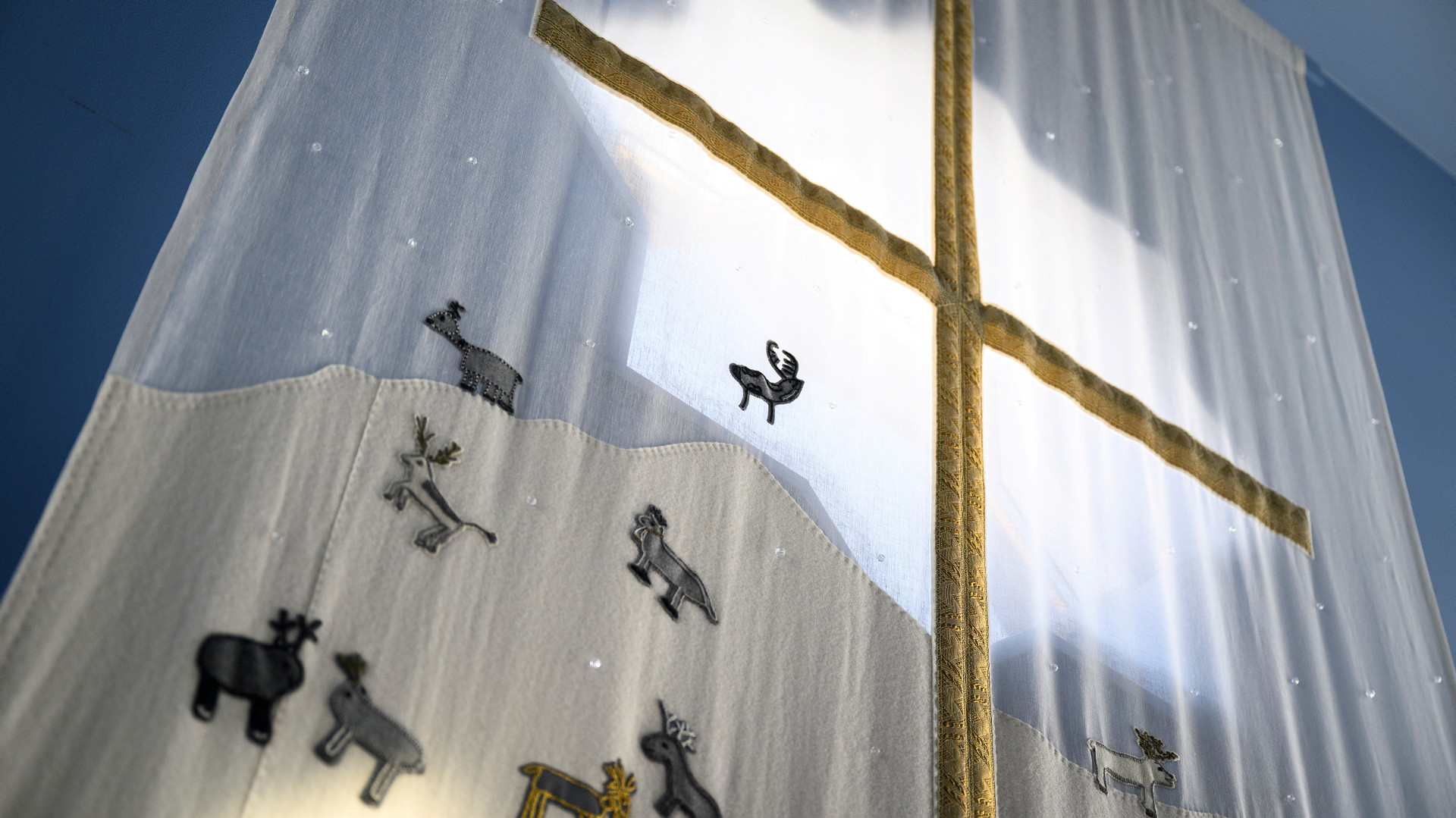 Reindeer appliqué work on curtains. Image by Magnus Aronson/Ikon.
Reindeer appliqué work on curtains. Image by Magnus Aronson/Ikon.
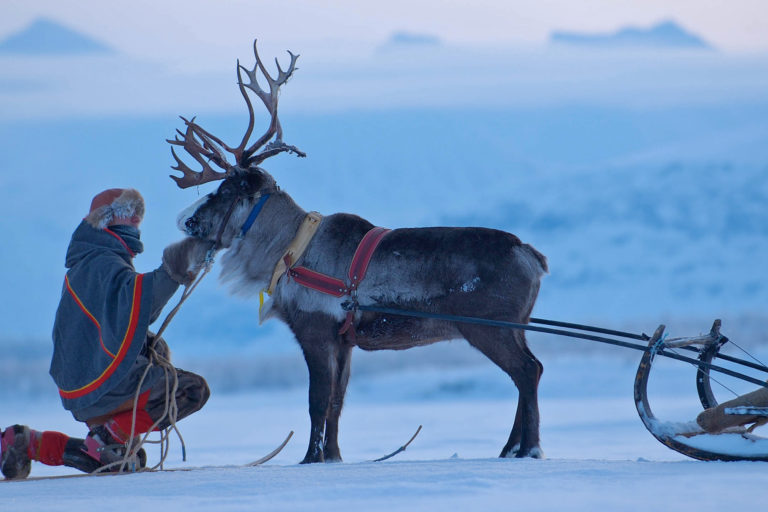 A member of the Sámi Indigenous people tends a reindeer in Sweden. Image by Staffan Widstrand/Rewilding Europe.
A member of the Sámi Indigenous people tends a reindeer in Sweden. Image by Staffan Widstrand/Rewilding Europe.
A growing number of progressive theologians want to go further in responding to the climate crisis by reforming the church’s theology itself to reflect the sustainable values of Indigenous Christian communities.
“In the 21st century, it’s just something that theologians have to talk about,” said David Lewis, a Ph.D. researcher in theology. “We have a climate crisis on our hands.
Not everyone is so convinced. Nordic churches have also been reluctant to end their logging of Sámi forests, which provide significant funds for church upkeep. Motions to protect the forests have consistently been voted down at synods; an internal review of the Church of Sweden’s forest management found a “strong financial focus” prioritized over environmental and sustainability goals.
There are other barriers to acceptance too. “Ecotheology is getting less controversial, even among the conservatives,” explained Tom Sverre Tomren, a theologian at VID Specialized University in Oslo. But some northerners still associate environmentalism with animal rights activists or urban conservationists who balk at Sámi hunting or close off traditional harvesting sites, he said.
More conservative wings of the church, like the Laestadian revivalist movement, are also more reluctant to incorporate some Sámi traditions in Christian worship, preaching a theology that sees traditional forms of animism as idolatry or blasphemy. Joiking in church remains controversial in many dioceses; one Norwegian vicar called the singing a remnant of the “old religion.” “This is something that, for centuries, people have been taught is the voice of the devil,” Webber said. “And if you teach people that it is wrong, then people will start thinking this way.”
Nordic — and Sámi — society is also rapidly secularizing, raising the question of whether ecotheology can have much influence at all. One study found just 30% of Swedish youth were confirmed in the church in 2014, compared with more than two-thirds in 1988, with similar drops in other Nordic countries. Twenty years ago, the leader of Norway’s Sámi Church Council, Ole Mattis Hetta, warned about how this transformation might threaten the survival of the traditional Sámi view of nature “as something God-given.” He once told Bientie in an interview, “The respect for nature and the sense of maintaining harmony that existed among the Sami only 30-40 years ago seems to be gone. This is the scourge of modernism, not a consequence of Christianity, but of the secularization of the Sami.”
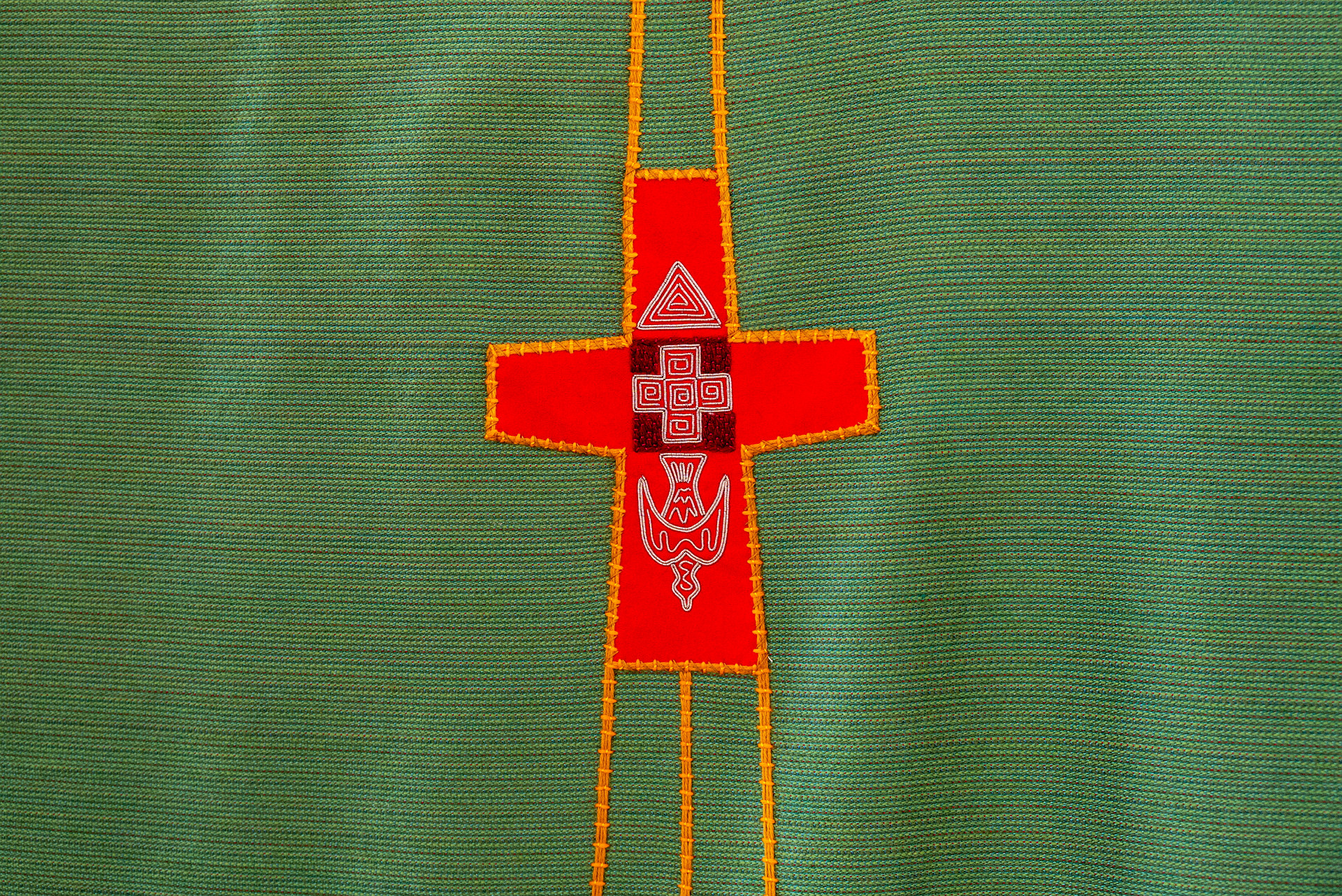 A chasuble with bird embroidery in Jokkmokk’s old church. Image by Emma Berkman/Ikon.
A chasuble with bird embroidery in Jokkmokk’s old church. Image by Emma Berkman/Ikon.
Other Sámi, meanwhile, fear the opposite — that the church might move too quickly to appropriate the same Indigenous traditions they once forced into the shadows. “I don’t know how much of our Christianity should be in the church,” Sjöberg said. “And I’m not sure that the church should be the driving force in this process.”
For Jernsletten, “It’s positive that the church wants to be inspired by the Indigenous traditions.” But both she and Sjöberg cautioned that until only recently, Sámi spirituality was an intensely private thing, often kept within families and very localized and diverse.
Still, Jernsletten said, it is work that increasingly must be done. More and more, Sámi are called upon to explain their spirituality in legal battles and political appeals to defend sacred sites and traditional practices.
Those conversations, she said, can be “very difficult.” But in the end, it may be worth it: A church that understands and respects Sámi faith, she said, will be a better ally in those fights.
Banner image: Service in Östersund. Image by Magnus Aronson/Ikon.
Finland’s debate over Indigenous identity and rights turns ugly
Related listening from Mongabay’s podcast: We speak with Tero Mustonen about Snowchange Cooperative’s program that is rewilding Arctic and Boreal habitats using Indigenous knowledge. Listen here:
FEEDBACK: Use this form to send a message to the author of this post. If you want to post a public comment, you can do that at the bottom of the page.
Christianity, Climate Change, Conservation, Conservation and Religion, Fish, Fishing, Human Rights, Indigenous Communities, Indigenous Culture, Indigenous Cultures, Indigenous Groups, Indigenous Peoples, Indigenous Rights, Logging, Mining, Religions, Traditional Knowledge, Traditional People
Arctic, Europe, Norway, Sweden
Author :
Publish date : 2024-07-17 17:22:28
Copyright for syndicated content belongs to the linked Source.
—-
Author : love-europe
Publish date : 2024-07-18 00:10:33
Copyright for syndicated content belongs to the linked Source.